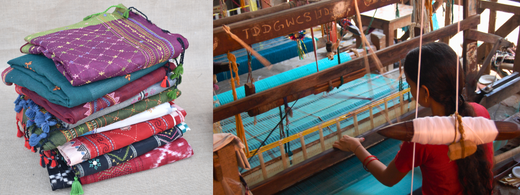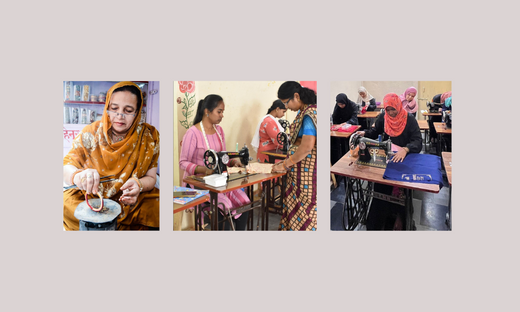
HANDLOOMS: A TESTAMENT TO TRADITION AND SUSTAINABILITY
The handloom industry in India is as old as time, dating back to the Indus Valley Civilization. This thriving, self-reliant industry faced its first major setback under British rule, when hand spun yarn was forcefully replaced with machine-made imports. This shift devastated the livelihoods of spinners and compromised the independence of weavers leaving them at the mercy of middlemen. The second blow came after the Industrial Revolution, with the influx of machine-made clothes and rising yarn costs creating unfair competition for handloom weavers.
During the Indian independence movement, the Swadeshi Movement sought to revive handlooms by promoting self-reliance and boycotting British products. However, post-1990s liberalization introduced new challenges, with competition from cheap imports and power loom imitations.
The Indian government has introduced several initiatives to support the handloom sector and improve the livelihoods of handloom weavers. The National Handloom Development Programme (NHDP) Scholarship Component, aims to bolster the handloom sector and enhance the lives of weavers. Under the Raw Material Supply Scheme, financial assistance is provided for raw materials, upgraded looms, and accessories. Additionally, the National Handicrafts Development Programme and the Comprehensive Handicrafts Cluster Development Scheme offer support for marketing, skill development, cluster development, direct benefits to artisans, and infrastructure and technology support.
In July 2015, the Union Government declared August 7th as National Handloom Day to raise awareness about the handloom industry’s socio-economic importance. Handloom weaving is more than a method of creating beautiful fabrics; it embodies sustainable living, cultural preservation, and economic support for countless artisans.
The enduring benefits of supporting handloom weaving
Sustainable Materials
Handloom textiles are often made from natural, sustainable materials such as cotton, silk, and wool. These materials are biodegradable and have a lower environmental footprint compared to synthetic fibers.
Non-Polluting Production Processes
The production process of handloom textiles is inherently sustainable. Handlooms do not require electricity, relying instead on human skill and labour. This absence of industrial machinery means that the process generates minimal pollution and does not emit environmentally harmful effluents. Dyes used in handloom fabrics are usually derived from natural sources, and are far less harmful than synthetic dyes.
Providing Livelihood to rural artisans
The Handloom Sector is one of the largest unorganized economic activities and it constitutes an integral part of the rural and semi-rural livelihood engaging over 35 lakh persons. The sector supports a vast network of artisans, including weavers, spinners, dyers, and other skilled workers. By promoting handlooms, we can help sustain these communities, enabling them to preserve their traditional skills and earn a dignified livelihood.
Preserving Traditional Crafts
Handloom weaving is deeply intertwined with India’s cultural heritage. Each region boasts its unique weaving techniques, patterns, and motifs, reflecting the local traditions and history. Handloom textiles such as Banarasi silk, Kanchipuram sarees, Pashmina shawls, and Mangalgiri cotton are cultural symbols. Preserving these age-old crafts, is crucial in honouring the rich social and cultural heritage of our country.
Promoting Slow Fashion
Handloom textiles offer a refreshing alternative to rapidly growing consumerism. These handmade fabrics are synonymous with slow fashion, which emphasizes quality, craftsmanship, and sustainability over mass production and disposability. Handloom products are often more durable and unique, encouraging consumers to invest in timeless pieces rather than ephemeral trends. This shift towards slow fashion can significantly reduce the environmental impact of the textile industry.
Empowering Women Artisans
The handloom sector engages over 25 lakh female weavers and allied workers which makes it an important source of economic empowerment of women. By providing women with opportunities to work from home or in cooperative societies, handloom weaving enables them to contribute economically while balancing their familial responsibilities. This empowerment through economic independence fosters gender equality and enhances the social status of women artisans.
Kritikala: An advocate for Handloom Heritage and Artisanal Craft
Kritikala’s dedication to supporting the handloom industry is exemplified in their collection of Mangalgiri cotton handloom sarees, each adorned with delicate hand embroidery crafted by their talented female artisans. These intricately embroidered sarees not only highlight the artistry of traditional handloom weaving but also provide the women artisans a platform to shine. Each saree is a testament to the blend of cultural heritage and contemporary craftsmanship, offering a unique piece of art that supports sustainable fashion.
Through their commitment, Kritikala preserves a vital tradition while uplifting the lives of countless women, making each purchase a meaningful contribution to both the handloom industry and the empowerment of female artisans.


Leave a comment
This site is protected by hCaptcha and the hCaptcha Privacy Policy and Terms of Service apply.